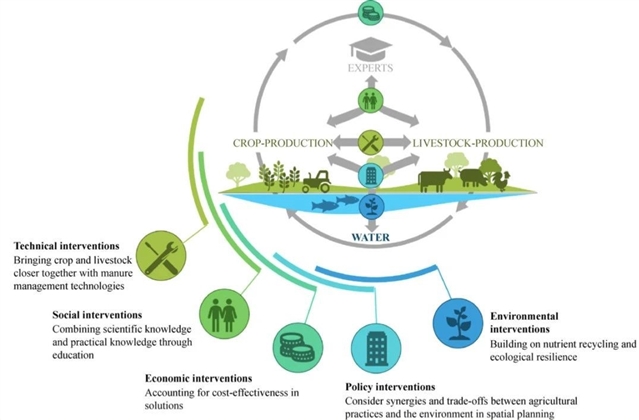论文标题:GREEN AGRICULTURE AND BLUE WATER IN CHINA: REINTEGRATING CROP AND LIVESTOCK PRODUCTION FOR CLEAN WATER (中国的绿色农业和碧水: 种养结合实现水体清洁)
期刊:Frontiers of Agricultural Science & Engineering
作者:Maryna STROKAL, Annette B.G. JANSSEN, Xinping CHEN, Carolien KROEZE, Fan LI, Lin MA, Huirong YU, Fusuo ZHANG, Mengru WANG
发表时间:28 Dec 2020
DOI:10.15302/J-FASE-2020366
微信链接:点击此处阅读微信文章
种养结合、绿色发展
Integrating Crop and Livestock Production Systems
专 辑 文 章 介 绍
· 第六篇 ·
▎论文ID
GREEN AGRICULTURE AND BLUE WATER IN CHINA: REINTEGRATING CROP AND LIVESTOCK PRODUCTION FOR CLEAN WATER中国的绿色农业和碧水: 种养结合实现水体清洁
期 刊:Frontiers of Agricultural Science and Engineering(FASE)
作 者 : Maryna STROKAL, Annette B.G. JANSSEN, Xinping CHEN, Carolien KROEZE, Fan LI, Lin MA, Huirong YU, Fusuo ZHANG, Mengru WANG通讯作者 : Maryna STROKALWater Systems and Global Change Group, Wageningen University & Research, 6708 PB Wageningen, the Netherlands. :maryna.strokal@wur.nl
Cite this article :
Maryna STROKAL, Annette B.G. JANSSEN, Xinping CHEN, Carolien KROEZE, Fan LI, Lin MA, Huirong YU, Fusuo ZHANG, Mengru WANG. GREEN AGRICULTURE AND BLUE WATER IN CHINA: REINTEGRATING CROP AND LIVESTOCK PRODUCTION FOR CLEAN WATER. Front. Agr. Sci. Eng., 2021, 8(1): 72-80https://doi.org/10.15302/J-FASE-2020366
· 文 章 摘 要 ·
作物和畜禽生产对于维持粮食安全至关重要。过去我国作物生产和畜禽生产结合地相对紧密。现今,小农户庭院式生产仍然保持着种养结合模式,但是规模化养殖场由于缺少配套的农田,其畜禽养殖与作物生产在空间上存在较大分离。种养分离导致我国畜禽粪便循环率和养分利用效率降低。养分的大量损失给我国水环境带了严重的污染问题。为扭转这一局势,需要通过重新结合作物生产与畜禽生产以促使农业“绿色”发展,生产满足人们需求的食物,同时以此实现中国的水系统“碧水”化,以确保当代和后代有清洁安全的水源。本研究总结了当前关于中国农业的科学认知,在此基础上确定了可行的种养结合干预措施,以控制农业对水体的污染;讨论了技术、社会、经济、政策和环境方面的干预措施,并进行了举例说明;重点介绍了能够在中国实现“绿色”农业和“碧”水的下一步举措。关键词:农业绿色发展,中国,净水,种养结合
· 文 章 亮 点 ·
1. 农业绿色发展(AGD)的目标是实现绿色环境、可持续农业和水质清洁。
2. 本文举例展示了农业对水质的影响。
3. 本文举例展示了能够同时实现可持续农业和改善水质的解决方案。
4. 农场内或农场间的种养结合系统是可行的。
5. 本文为进一步发展可持续农业提供了建议。
· 文 章 图 表 ·
图1 当今中国与水污染相关的农作物生产和畜禽生产概况(a),采取干预措施来发展绿色农业进而贡献未来的碧水(净水)的美好未来(b)。

图2 五种促使作物生产与畜禽生产结合而实现清洁水体的干预措施。 这五项干预措施分别为技术、社会、经济、政策和环境。 图中给出了每种干预措施的示例。

摘要
Crop and livestock production are essential to maintain food security. In China, crop and livestock production were integrated in the past. Today, small backyard systems are still integrated but the larger livestock farms are landless and largely geographically separated from crop production systems. As a result, there is less recycling of animal manures and there are lower nutrient use efficiencies in the Chinese food production systems. This, in turn, results in considerable losses of nutrients, causing water pollution and harmful algal blooms in Chinese lakes, rivers and seas. To turn the tide, there is a need for agricultural “green” development for food production through reintegrating crop and livestock production. An additional wish is to turn the Chinese water systems “blue” to secure clean water for current and future generations. In this paper, current knowledge is summarized to identify promising interventions for reintegrating crop and livestock production toward clean water. Technical, social, economic, policy and environmental interventions are addressed and examples are given. The paper highlights recommended next steps to achieve “green” agriculture and “blue” water in China.
▎下篇预告
INTEGRATED CROP-LIVESTOCK SYSTEMS: LESSONS FROM NEW YORK, BRITISH COLUMBIA, AND THE SOUTH-EASTERN UNITED STATES
发展种养结合:纽约、不列颠哥伦比亚和美国东南部地区的经验分享
《前沿》系列英文学术期刊
由教育部主管、高等教育出版社主办的《前沿》(Frontiers)系列英文学术期刊,于2006年正式创刊,以网络版和印刷版向全球发行。系列期刊包括基础科学、 、工程技术和人文社会科学四个主题,是我国覆盖学科最广泛的英文学术期刊群,其中13种被SCI收录,其他也被A&HCI、Ei、MEDLINE或相应学科国际权威检索系统收录,具有一定的国际学术影响力。系列期刊采用在线优先出版方式,保证文章以最快速度发表。
高等教育出版社入选“中国科技期刊卓越行动计划”集群化项目。Frontier系列期刊中:13种被SCI收录;1种被A&HCI收录;6种被Ei收录;2种被MEDLINE收录;11种中国科技核心期刊;16种被CSCD收录。
中国学术前沿期刊网
http://journal.hep.com.cn

特别声明:本文转载仅仅是出于传播信息的需要,并不意味着代表本网站观点或证实其内容的真实性;如其他媒体、网站或个人从本网站转载使用,须保留本网站注明的“来源”,并自负版权等法律责任;作者如果不希望被转载或者联系转载稿费等事宜,请与我们接洽。